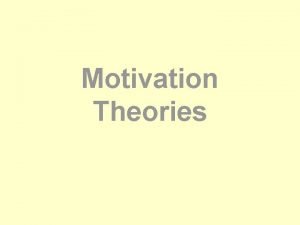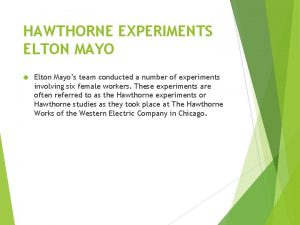Elton Mayo the Philadelphia Mill Philadelphia Textile Mill





- Slides: 5

Elton Mayo & the Philadelphia Mill

Philadelphia Textile Mill Study Philadelphia Textile was a model and a successful organization. during the early 20 th century, a spinning unit of this mill developed certain problems such as absenteeism, high labor turnover (25%- number of workers joining and leaving the organization). Due to this the organization was facing heavy losses. However, many managers were called for the solution but all the efforts went fruitless.

Eventually, it was referred to Harvard School of Business Administration where that was assigned to Elton Mayo. When Mayo visited the unit, he found that the working conditions inside the unit are very noisy and the workers were working for very long hours without any rest. Mayo took a simple initiative by introducing few rest periods or rest pauses between the work hours. Very surprisingly, the absenteeism reduced, turnover vanished and productivity increased.

After some period the manager withdrew the rest periods which resulted into the previous conditions of absenteeism and loss of productivity. Keeping in view the present condition, the managers introduced the rest periods with conditions and linking it with production. Again, the absenteeism reduced but productivity did not increase to the previous levels. In the long run, Rest Periods were introduced without conditions which brought the productivity to the previous level.

Conclusions Elton Mayo made some sorts of conclusions from the present study which are following: - a) Because of repeated working activities the work had become monotonous which caused boredom and eventually fatigue to the workers. b) Lack of interaction was a factor limiting the social life of workers. c) However, the introduction of Rest Pauses enabled the workers to interact with each other and able to adjust to the boredom of the work. It also relieved their fatigue. Because of this the absenteeism stopped and the workers were able to concentrate on work.








